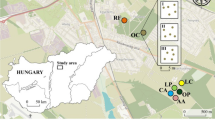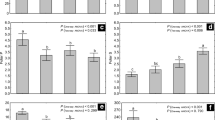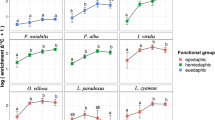Abstract
Biomass, abundance, species composition of collembola, soil water content, and bulk density were investigated in four hop fields in Southern Bavaria. For each soil type, one field was supplied only with mineral fertilizers, and the second was additionally cultivated with underseed (oil-seed rape) to provide a green manure. Soils within and between rows were sampled separately over 2 years. The highest biomass of collembola was found in the sandy soil with underseed, whereas the individual numbers were highest in the loamy soil with underseed. In many cases total individual numbers and abundances of single species differed between soil types, green manure/mineral fertilization, and the sampling points (plant rows/rows between the plants). There were significant but low negative correlations between individual numbers of single species and water content (except for Isotomurus palustris) or bulk density. All results of this study were based on very common, widespread species. It is concluded that species abundances of collembola, even if they are euryoecious, are good indicators of soil type and different environmental conditions within the same soil type. The investigation of abundance and biomass showed that none of these parameters on its own was appropriate to compare populations either between or within the habitats investigated. Since both individual numbers and the standing crop of a population are important for nutrient turnover, in studies dealing with element fluxes their comparative analysis is indispensable.
Similar content being viewed by others
References
Agrell I (1941) Zur Ökologie der Collembolen. Opusc Ent Suppl 3:1–236
Ahrens B (1989) Die Collembolenfauna landwirtschaftlich genutzter Flächen in der Umstellungsphase von konventionellem auf ökologischen Landbau. PhD thesis, University of Bonn
Andren O (1984) Soil mesofauna of arable land and its significance for decomposition of organic matter. PhD thesis, University of Uppsala, Institutionen for Ekologi och Miljovard, Sveriges Landbruksuniversitet, Rapport 16
Bengtsson G, Gunnarsson T, Rundgren S (1983) Growth changes caused by metal uptake in a population of Onychiurus armatus (Collembola) feeding on metal polluted fungi. Oikos (Denmark) 40:216–225
Bödvarsson H (1961) Beitrag zur Kenntnis der südschwedischen bodenlebenden Collembolen. Opuscula Entomologica (Lund) 26:178–198
Christiansen K (1964) Bionomics of Collembola. Annu Rev Entomol 9:147–178
Curry JP (1986) Effects of management on soil decomposers and decomposition processes in grassland. In: Mitchell MJ, Nakas JP (eds) Microfloral and faunal interactions in natural and agro-ecosystems. Nijhoff/Junk Publishers, Dordrecht, pp 349–398
Didden WAM (1987) Reactions of Onychiurus fimatus (Collembola) to loose and compact soil. Methods and first results. Pedobiologia 30:93–100
Domsch KH (1985) Funktionen und Belastbarkeit des Bodens aus der Sicht der Bodenmikrobiologie. Kohlhammer, Stuttgart
Dunger W (1968) Produktionsbiologische Untersuchungen an der Collembolenfauna gestörter Böden. Pedobiologia 8:16–22
Dunger W (1982) Die Tiere des Bodens als Leitformen für anthropogene Umweltveränderungen. Decheniana Beih Bonn 26:151–157
Filser J (1991) Sommer-und Wintergesellschaften der epigäischen Collembolen in Hopfengärten unterschiedlicher Bewirtschaftung. Verh Ges Ökol XX/I:55–60
Filser J (1993) Die Bodenmesofauna unter der landwirtschaftlichen Intensivkultur Hopfen: Anpassung an bewirtschaftungsbedingte Bodenbelastungen? In: Ehrnsberger R (ed) Bodenmesofauna und Naturschutz. Informationen zu Naturschutz und Landschaftspflege in Nordwestdeutschland, BSH, Wardenburg, 5:368–386
Filser J, Fromm H, Nagel R, Winter K (1994) Long-lasting negative effects of intensive agricultural management on the biodiversity of the soil fauna. Plant and Soil (in press)
Fjellberg A (1980) Identification keys to Norwegian Collembola. Norsk Entomologisk Forening. As
Gisin H (1943) Ökologie und Lebensgemeinschaften der Collembolen im Schweizerischen Exkursionsgebiet Basels. Rev Suisse Zool 50:131–224
Gisin H (1960) Collembolenfauna Europas. Museum d'histoire naturelle, Genf
Haarlov N (1960) Microarthropods from Danish soils. Oikos 3:1–176
Heimann-Detlefsen D (1991) Auswirkungen eines unterschiedlich intensiven Pflanzenschutz-und Düngemitteleinsatzes auf die Collembolenfauna des Ackerbodens. PhD thesis, Technical University of Braunschweig
Heisler C (1990) Collembolen und Raubmilben auf unterschiedlich verdichteten Ackerflächen unter Getreide. Verh Ges Ökol 19:262–267
Hüther W (1961) Ökologische Untersuchungen über die Fauna pfälzischer Weinbergsböden mit besonderer Berücksichtigung der Collembolen und Milben. Zool Jahrb Syst 89:243–368
Kneitz G, Kloft WJ (1988) Untersuchungen zur Ermittlung und Bewertung tierischer Bioindikatoren im Agraökosystem des Weinberges. Spez Ber KFA, Jülich, 439:702–907
Lagerlöf J (1987) Ecology of soil fauna in arable land. Dynamics and activity of microarthropods and enchytraeids in four cropping systems. PhD thesis, University of Uppsala, Institutionen for Ekologi och Miljovard, Sveriges Landbruksuniversitet, Rapport 29
Ponge J-F (1983) Les collemboles, indicateurs du type d'humus en milieu forestier. Résultats obtenus en Sud de Paris. Acta Oecol, Oecol Gen 4:359–374
Posthuma L (1992) Genetic ecology of metal tolerance in Collembola. PhD thesis, Vrije Univ Amsterdam, NL Febodruck (Enschede)
Schleuter M (1981) Die Collembolenfauna des Dauerdüngungsversuchs Dikopshof. Decheniana 134:162–171
Sohlenius B (1990) Influence of cropping system and nitrogen input on soil fauna and microorganisms in a Swedish arable soil. Biol Fertil Soils 9:168–173
Verhoef HA (1977) Soil moisture and the population dynamics of coexisting Collembola. Ecol Bull (Stockholm) 25:480–482
Verhoef HA, Nagelkerke CJ (1977) Formation and ecological significance of aggregations in Collembola. Oecologia 31:215–226
Visser S (1985) Role of the soil invertebrates in determining the composition of soil microbial communities. In: Fitter AH, Atkinson D (eds) Biological interactions in soil. Blackwell Scientific Publishers, Oxford, pp 297–317
Winter K, Beese F (1995) The spatial distribution of soil microbiol biomass in a permanent row crop. Biol Fertil Soils 19:322–326
Zerling L (1990) Zur Sukzession von Kleinarthropoden, insbesondere Collembolen, im Bodenbildungsprozeß auf einer landwirtschaftlich genutzten Braunkohlekippe bei Leipzig. Pedobiologia 34:315–335
Author information
Authors and Affiliations
Rights and permissions
About this article
Cite this article
Filser, J. The effect of green manure on the distribution of collembola in a permanent row crop. Biol Fertil Soils 19, 303–308 (1995). https://doi.org/10.1007/BF00336099
Received:
Issue Date:
DOI: https://doi.org/10.1007/BF00336099




